

Paleontology. Paleontology or palaeontology (/ˌpeɪlɪɒnˈtɒlədʒi/, /ˌpeɪlɪənˈtɒlədʒi/ or /ˌpælɪɒnˈtɒlədʒi/, /ˌpælɪənˈtɒlədʒi/) is the scientific study of prehistoric life.

It includes the study of fossils to determine organisms' evolution and interactions with each other and their environments (their paleoecology). Paleontological observations have been documented as far back as the 5th century BC. The science became established in the 18th century as a result of Georges Cuvier's work on comparative anatomy, and developed rapidly in the 19th century. The term itself originates from Greek παλαιός, palaios, i.e. "old, ancient", ὄν, on (gen. ontos), i.e. Paleontology lies on the border between biology and geology, but differs from archaeology in that it excludes the study of morphologically modern humans.
Dinosaur. Dinosaurs are a diverse group of animals of the clade Dinosauria. They first appeared during the Triassic period, 231.4 million years ago, and were the dominant terrestrial vertebrates for 135 million years, from the beginning of the Jurassic (about 201 million years ago) until the end of the Cretaceous (66 million years ago), when the Cretaceous–Paleogene extinction event led to the extinction of most dinosaur groups at the close of the Mesozoic Era.
The fossil record indicates that birds evolved from theropod dinosaurs during the Jurassic Period and, consequently, they are considered a subgroup of dinosaurs by many paleontologists.[1] Some birds survived the extinction event that occurred 66 million years ago, and their descendants continue the dinosaur lineage to the present day.[2] Etymology Definition. Theropoda. Biology[edit] Diet[edit] Theropods exhibit a wide range of diets, from insectivores to herbivores and carnivores. Strict carnivory has always been considered the ancestral diet for theropods as a group, and a wider variety of diets was historically considered a characteristic exclusive to the avian theropods (birds). However, discoveries in the late 20th and early 21st centuries showed that a variety of diets existed even in more basal lineages.[1] All early finds of theropod fossils showed them to be primarily carnivorous.
Fossilized specimens of early theropods known to scientists in the 19th and early 20th centuries all possessed sharp teeth with serrated edges for cutting flesh, and some specimens even showed direct evidence of predatory behavior. The first confirmed non-carnivorous fossil theropods found were the therizinosaurs, originally known as segnosaurs. Allosaurus. As the most abundant large predator in the Morrison Formation, Allosaurus was at the top of the food chain, probably preying on contemporaneous large herbivorous dinosaurs and perhaps even other predators.
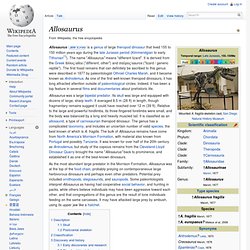
Potential prey included ornithopods, stegosaurids, and sauropods. Some paleontologists interpret Allosaurus as having had cooperative social behavior, and hunting in packs, while others believe individuals may have been aggressive toward each other, and that congregations of this genus are the result of lone individuals feeding on the same carcasses. It may have attacked large prey by ambush, using its upper jaw like a hatchet. Ceratosauria. Ceratosaurs are members of a group of theropod dinosaurs defined as all theropods sharing a more recent common ancestry with Ceratosaurus than with birds.
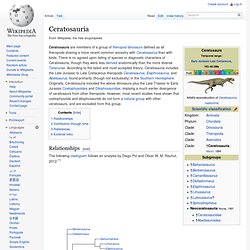
There is no agreed upon listing of species or diagnostic characters of Ceratosauria, though they were less derived anatomically than the more diverse Tetanurae. According to the latest and most accepted theory, Ceratosauria includes the Late Jurassic to Late Cretaceous theropods Ceratosaurus, Elaphrosaurus, and Abelisaurus, found primarily (though not exclusively) in the Southern Hemisphere. Originally, Ceratosauria included the above dinosaurs plus the Late Triassic to Early Jurassic Coelophysoidea and Dilophosauridae, implying a much earlier divergence of ceratosaurs from other theropods. However, most recent studies have shown that coelophysoids and dilophosaurids do not form a natural group with other ceratosaurs, and are excluded from this group. Ceratosaurus. Description[edit] Artist's impression of C. nasicornis Comparison of two specimens of C. nasicornis (red, pink) and other theropods from the Morisson Formation Cast of the hand of C. nasicornis (AMNH 27631) Ceratosaurus, at first glance, looked like a fairly typical theropod,[1] however its skull was quite large in proportion to the rest of its body[2] and possessed a prominent nose horn formed from protuberances of the nasal bones.[3] In addition to the large nasal horn, Ceratosaurus possessed smaller hornlike ridges in front of each eye, similar to those of Allosaurus, these ridges were formed by enlargement of the lacrimal bones.[4] Uniquely among theropods, Ceratosaurus possessed dermal armor, in the form of small osteoderms running down the middle of its back.[5] Its tail comprised about half of the body's total length and was thin and flexible, with high vertebral spines.[2] The bigger specimen was later assigned by James H.
Abelisauridae. Like most theropods, abelisaurids were carnivorous bipeds.
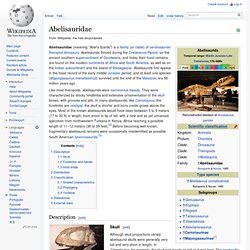
They were characterized by stocky hindlimbs and extensive ornamentation of the skull bones, with grooves and pits. In many abelisaurids, like Carnotaurus, the forelimbs are vestigial, the skull is shorter and bony crests grows above the eyes. Carnotaurus. Carnotaurus /ˌkɑrnɵˈtɔrəs/ is a genus of large theropod dinosaur that lived in South America during the Late Cretaceous period, between about 72 and 70 million years ago. The only species is Carnotaurus sastrei. Known from a single well-preserved skeleton, it is one of the best-understood theropods from the Southern Hemisphere. The skeleton, found in 1984, was uncovered in the Chubut Province of Argentina from rocks of the La Colonia Formation. Derived from the Latin carno [carnis] ("flesh") and taurus ("bull"), the name Carnotaurus means "meat-eating bull", alluding to its bull-like horns. Spinosauridae. Spinosauridae is a family of specialised theropod dinosaurs.
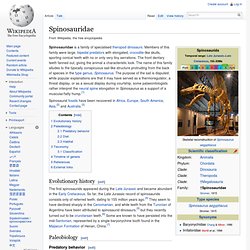
Members of this family were large, bipedal predators with elongated, crocodile-like skulls, sporting conical teeth with no or only very tiny serrations. Spinosaurus. Description Size Life restoration of S. aegyptiatus Since its discovery, Spinosaurus has been a contender for the longest and largest theropod dinosaur.
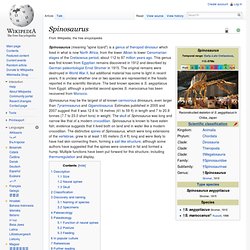
Both Friedrich von Huene in 1926[1] and Donald F. Glut in 1982 listed it as among the most massive theropods in their surveys, at 15 meters (49 ft) in length and upwards of 6 t (5.9 long tons; 6.6 short tons) in weight.[2] In 1988, Gregory Paul also listed it as the longest theropod at 15 meters (49 ft), but gave a lower mass estimate of 4 tonnes (3.9 long tons; 4.4 short tons).[3] Size comparison of selected giant theropod dinosaurs, S. aegyptiacus in red. Neural spines. Siamosaurus. Siamosaurus (meaning "Siamese lizard") is a genus of theropod dinosaur from Early Cretaceous Thailand.
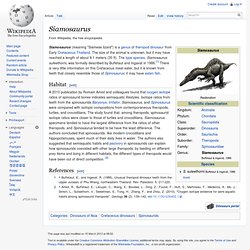
The size of the animal is unknown, but it may have reached a length of about 9.1 meters (30 ft). The type species, Siamosaurus suteethorni, was formally described by Buffetaut and Ingavat in 1986.[1] There is very little information on this Cretaceous meat-eater, but it is known from teeth that closely resemble those of Spinosaurus; it may have eaten fish.
Habitat[edit] A 2010 publication by Romain Amiot and colleagues found that oxygen isotope ratios of spinosaurid bones indicates semiaquatic lifestyles. Ostafrikasaurus. Ostafrikasaurus is a genus of spinosaurid theropod dinosaurs known from the Jurassic of Tendaguru, southeastern Tanzania.
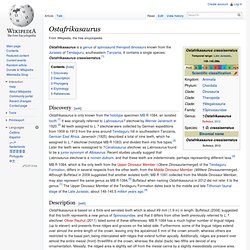
It contains a single species, Ostafrikasaurus crassiserratus.[1] Discovery[edit] Ostafrikasaurus is only known from the holotype specimen MB R 1084, an isolated tooth.[1] It was originally referred to Labrosaurus? Chilantaisaurus. Chilantaisaurus ("Ch'i-lan-t'ai lizard") is a genus of neovenatorid theropod dinosaur from the late Cretaceous Ulansuhai Formation of China (Turonian stage, about 92 million years ago).

The type species, C. tashuikouensis, was described by Hu in 1964. Chilantaisaurus was a large theropod, estimated as weighing between 2.5 metric tons (2.8 short tons)[1] and 4 metric tons (4.4 short tons).[2] Recently, Brusatte et al. (2010) estimated it to weigh 6,000 kilograms (13,000 lb), based on femur length measurements.[3] Classification[edit] Hu considered Chilantaisaurus to be a carnosaur related to Allosaurus,[4] though some subsequent studies suggested that it may be a spinosauroid, possibly a primitive member of the spinosaurid family (Sereno, 1998; Chure, 2002; Rauhut, 2001) because it had large claws on the forelimbs thought to be unique to that group.
Several species have been described based on very poor remains. Baryonyx. Baryonyx is one of the few known piscivorous (fish-eating) dinosaurs, with specialized adaptations like a long low snout with narrow jaws filled with finely serrated teeth and gaff-hook-like claws to help it hunt its main prey.

Description[edit] Cristatusaurus. Cristatusaurus (meaning "Crested reptile") is an extinct genus of spinosaurid theropod dinosaur. It lived during the Early Cretaceous Period of what is now Africa. Alternate views of the jaw fragments Its fossils were found at Gadoufaoua in Niger, Africa, in 1973. These fossils are quite similar to those of Baryonyx and Suchomimus. Ichthyovenator.
Ichthyovenator is a spinosaurid theropod dinosaur from the Early Cretaceous of Laos. Suchomimus. Spinosauridae. Suchosaurus. Sinopliosaurus (dinosaur) Irritator. For other meanings see irritation and wikt:irritate. Oxalaia. Tyrannosauridae. Daspletosaurus. Daspletosaurus is closely related to the much larger and more recent Tyrannosaurus. Gorgosaurus. Like most known tyrannosaurids, Gorgosaurus was a bipedal predator weighing more than two metric tons as an adult; dozens of large, sharp teeth lined its jaws, while its two-fingered forelimbs were comparatively small.
Gorgosaurus was most closely related to Albertosaurus, and more distantly related to the larger Tyrannosaurus. Gorgosaurus and Albertosaurus are extremely similar, distinguished mainly by subtle differences in the teeth and skull bones. Some experts consider G. libratus to be a species of Albertosaurus; this would make Gorgosaurus a junior synonym of that genus. Gorgosaurus lived in a lush floodplain environment along the edge of an inland sea. Alioramus. Alioramus (/ˌæli.ɵˈreɪməs/; meaning 'different branch') is a genus of tyrannosaurid theropod dinosaurs from the Late Cretaceous period of Asia. The type species, A. remotus, is known from a partial skull and three foot bones recovered from Mongolian sediments which were deposited in a humid floodplain about 70 million years ago. These remains were named and described by Soviet paleontologist Sergei Kurzanov in 1976. Nanotyrannus. Albertosaurus. Tyrannosaurus. Tarbosaurus. Carcharodontosauridae. Tyrannotitan.
Giganotosaurus. Carcharodontosaurus. Sauropoda. Fossil. Trace fossil.